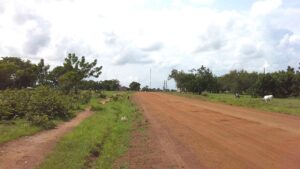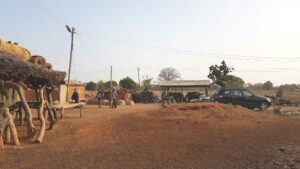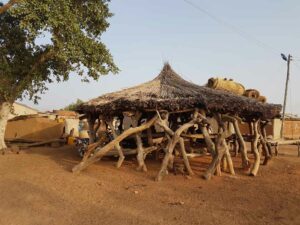Ghanatta Ayaric
Hard Road to Travel
October 2013
“…How can the clamour of sounds be still? There is no void where noises can collect and be made mute before they re-escape…!” (Linton Kwesi Johnson, British-Jamaican Dub Poet and Race Relations Activist)

The Sandema-Wiaga Road
It is a torturous journey. I am driving at walking speed on the five-kilometre stretch of road between Sandema and Wiaga. It is in a terrible state. Pothole infested, it has been in that condition for as long as I have known it; since my childhood days through my adolescence in the 1970s, when on several occasions I walked the distance from either Sandema to Gbedema or vice-versa on days which were not Sandema or Fumbisi market days, the only days on which it was possible to take one of the many overloaded lorries, popularly known as “waatonkyini”, and compete with loads of market goods for space inside them. The rooftops of the vehicles would also be overloaded with people, sacks of maize, millet and other wares as well as goats, sheep and guineafowls. In those days, few people in the area owned private vehicles, and motorbikes were not common, so the chances of getting a lift by such means were almost non-existent. At best, one got a lift on a tractor. The only vehicles belonging to Bulsa people were Gariba Adiita’s Mercedes Benz bus with the inscription “no condition is permanent” and Abukari’s wooden truck which also had “mind the engine, don’t mind the body” boldly written on it. Years later, another market vehicle owned by someone who eventually settled in Sandema was added to the number. That truck had the inscription, “so mae soonka” (which means “like those who like you”, roughly translated from the Hausa language). The road has not seen any improvement since those days. It has become worse, the worst road I have ever used.
But it has a beauty: the stretch of it running through Sandema township from Bilinsah to Suwarinsah is lined by a canopy of mahogany trees. Planted nearly hundred years ago by the then district colonial administration with the help of the appointed traditional chiefs, the mahogany trees have become a landmark of Sandema. How nice it would be if they lined the road all the way to Wiaga! We have maintained many things, good and bad, bequeathed to us by the British, but the culture of tree-planting /growing never stuck. How unfortunate. In times of climate change, it is a useful culture to take seriously and imbibe in the young generation.
I drive very slowly, going into one pothole and coming out only to enter the next. To the left is Sandema Old Primary, the alma mater of the first generation of educated Bulsa people, mostly teachers, one of whom was my own father, Eric Akanpaanab Ayaric. Images of the year I attended school there from 1967 -1968 cross my mind. I still picture very vividly the headteacher, Mr Raphael Adiita, in his immaculate uniform, white shirt and shorts, and brown leather sandals to match. I remember him as a very strict teacher who didn´t spare the cane, but more as an exceptionally good and competent teacher. No wonder medical doctors, university professors, lawyers, farmers, businessmen and women and countless civil and public servants make the long list of his former pupils. He laid the foundation for their successful careers in life.
I steer from the narrow strip of red earth passing for a road to the side and wait behind a heap of gravel to allow an oncoming truck to pass. The heaps of gravel are the latest signs of attempts to get the main feeder road upgraded to a tolerable level for its users. They lie within ten metres of each other all the way from Sandema Old Primary School to Wiak-Gonsa. Even without the heaps of gravel, it is impossible for two vehicles to pass each other without the one stopping for the other to past. The deep potholes would not allow it.
When I resume my snail-slow driving, I stop after some fifty metres to give a lift to three women who are walking in the same direction. Their destination is Wiak-Gonsa. Mine is Gbedema. The youngest of the three women is carrying a child strapped to her back in a cloth and balancing a big bowl of load on her head. The other two are old, in their late sixties probably, but it is hard to tell for sure. They could even be in their mid-seventies. They start thanking me even before they make themselves comfortable in the empty seats of the car and we drive off at the same walking speed, in silence, my mind trying to figure out why the road has been left to deteriorate to the state in which it currently is, a major feeder road connecting two commercial centres, the two big market towns in Bulsaland, Sandema and Fumbisi. “Siuku kaasi yoo,” I remark to the women. “Hmm, siuku ka chengka… ku ka chengka koraa,” the youngest of the three women added. What else is there to say about the road other than that it is in a terrible condition. It has taken many lives, mostly motorbike riders. More than six such victims immediately come to mind, young men. Who is to blame, the district administration comprising the district chief executive, district coordinating director and district assembly, the members of parliament for Bulsa, central government or all taken together? We return to our silence while the car goes down one pothole after the other and reach Wiak-Gonsa after nearly half an hour! The women get off, thanking me incessantly. On large billboards along the road are pictures of parliamentary candidates of the two main political parties, the National Democratic Congress (NDC) and the National Patriotic Party (NPP) and their respective flagbearers, John Dramani Mahama and Nana Addo Dankwah Akufo-Addo. Their broad smiles and promissory slogans about bringing development to Bulsaland and thereby improving and transforming mock the people of Bulsaland and all those who use this death trap of a road on a daily and regular basis.
Having just taken over half an hour to cover by car a five-kilometre road, the Better Ghana slogans underline the anomalies of Ghana’s politics and nascent parliamentary democracy. They remind me of the Reggae song by my CapeVars mate and a good musician friend, Ali Nasamu aka Zongoman, which talks about giving gorillas bananas and asking them to share these with monkeys. If you believe “monkey go see banana”, then you are one of the constituents who vote every four years for the faces smiling cynically on the billboards. Aren’t they the same people who put the politicians in power? Aren’t they the same constituents who go to sleep after elections and fail to hold their elected representatives accountable? The winners always take the whole victory, and unscrupulously merciless, too, most often. Yes, it’s the nature of politics in Ghana, indeed the whole of Africa. Ghana has been beaten to coma since the overthrow of Kwame Nkrumah, the only visionary and selfless progressive leader the country has known till today.
At Wiak-Gonsa I decide to make a pause from the long journey from Sandema before continuing to Gbedema. I visit one of my young friends, Evans Akangyelewon Atuick, the baritone voiced university lecturer and founder-manager of Wiaga United Football Club, and we go for a “pobla” lunch. While enjoying our high protein steamed bean-flour dish, we exchange bits and pieces on social and educational matters in Buluk. The young man is refreshing to listen to in his deep insight and engagement in these subjects.
Road accident victims
I take leave of Evans and continue my journey to my home village, Gbedema. Along the road and stretching into the bush are large tracts of land covered mostly in green shea trees and an occasional giant baobab, all contrasting with the stretch of red earth on which I´m travelling. The condition of the road remains the same, the only difference between it and the stretch from Sandema to Wiaga is the absence of heaps of gravel. I wonder what driving on it would be like at the peak of the rainy season when the potholes are usually filled with water, and the mixture of gravel, mud and clay on the surface makes it slippery. It’s difficult to believe that vehicles ply it on a regular basis, carrying passengers and goods to and from Fumbisi market, and that it also leads to the fertile valleys of Wiesi and Gbedembilsi which, properly managed to allow all year farming, could produce almost all of Ghana’s rice needs. It would give the youth gainful employment opportunities and thereby curb their exodus to the big cities in the South of Ghana, Accra and Kumasi in particular. And it would also reduce the country’s heavy reliance on imported rice from Asia.
I pass the part of the road where a young man I knew died a year ago when he collided with another motorbike rider while attempting to avoid the ubiquitous potholes. I had met Agong Atik, from Fumbisi, two days earlier in Chuchuliga on my way to Navrongo in the company of my brother, Pascal Ayaric. We had stopped to help a motorbike rider who had collided with a donkey. A young man wearing a red, gold and green Rasta beanie (and the Rastaman calls it “crown”) was at the scene giving the victim first aid, cleaning his bruised and bleeding hands. Short sprouts of dreadlocks showed from under the beanie where it didn’t cover the entire head. Recognizing my brother, he walked up to tell us all was well with the accident victim and that we could continue our journey. One had to be very careful with animals on the road, donkeys especially, which can suddenly start racing from nowhere and end up on the road, he added. Pascal introduced me as his older brother, to which Agong said he had heard my name before but never met me in person. My brother added that I was a close friend of Agong’s sister, Christine Atik, who lives in Switzerland. We shook hands and exchanged a few words. It was the first and last time the two of us were to meet. Agong died in a motor accident on the Gbedema-Wiaga road two days later.
I had returned to Gbedema a day earlier. When I woke up the next morning, there was news of a young man who had died in an accident the night before. His name was given as Agong. When I enquired further, it was confirmed that it was the young man that I had met on my way to Navrongo two days ago! I rode to the scene of the accident and a horrible picture greeted me. Agong had apparently been hurled meters away from his motorbike and landed on the head. The red earth had soaked in his blood and the Rasta red gold and green hat I had seen him wearing was still lying there, soaked in his blood. His motorbike had been taken to a nearby house after the accident and his body conveyed to Fumbisi and handed over to a grieving family, among them a young wife and two little children. The bad road had taken yet another young life, a breadwinner and head of a family, wiped out in the prime of his life. The bad road has already claimed many lives. Agong’s was only the most recent one. Where its victims had not died, it had left them with deep scars and maimed bodies, broken limbs and toothless mouths!
My driving ordeal ends at the compound house of my extended family, Gbedem-nab yeri. I came to the world in a mud room here, and it still stands where it was in 1957, rebuilt at regular yearly intervals, but on the same spot.
I make myself comfortable in the kusung, seated on dampala and surrounded by uncles, cousins, and nephews. The greeting is lengthy, passes from one “mouth” to the other and finally given to the eldest member of the extended family, an uncle, Ayomah, senior of the three remaining sons of my grandfather, Ayaric Akaa-nyemi. Akanbisa and Awen-nying are the other two sons. My grandfather was the first “zutok-muning” (red cap) chief of Gbedema (chiefs installed to facilitate the colonial policy of Indirect Rule pursued by the British in Ghana and Nigeria). Installed by Sandemnab Afoko Ayieta somewhere in the first decade of the twentieth century, Ayaric ruled until 1970. He lies buried in the inner courtyard, my grandmother´s part of the compound, close to the room in which I was born. When my uncle accepts the greeting, it lasts some minutes, containing enquiries about my condition of health and that of people in my life mentioning those he knows by their names as “Anabiik ka, ani Alariba Amelinjam mi li wa dokdem maa?” (And how about Anabiik, and Alariba Amelimjam and her family?). He hopes my work is smooth and progressing well. In return I ask almost the same questions and his responses assure me that all is well in the extended family. A few members of the family had passed on though, he informs me, adding that it is the wish of the Almighty and no one is here for eternity. “Taa juisi ka nyinyogsa-nga nyini” (We only ask for good health in this life). The formal welcoming greeting comes to an end, and there is a brief pause in silence, as if to allow time for the wishes expressed in the words to reach the ancestors, for onward transmission to God – Naawen!
I have missed the kusung and its atmosphere of conversations and laughter a lot. Lying in it now brings a pleasant sense of serenity to my spirit. When I was growing up, kusung was one of my favourite daytime places in our traditional compound home, like the dabiak (inner courtyard of each apartment) was at night.
The kusung is not only where members of the extended family gather to deliberate issues or just converse leisurely, and relax too. It is a symbol of Bulsa hospitality. Strangers and visitors are received and welcomed there with zo-nyiem (millet-flour water). Every Bulsa compound has a kusung!

The open space (pielim) in front of the Gbedem-nab Compound. On the left: part of the kusung with dampala (seating logs); in the middle: ancestral shrines (bogluta); on the right: Ghanatta’s car

Kusung
- Patrick Seidu aka Saala-Biik Soakatoa: My Life and Career
- Franz Kröger: Daniel Bukari, an Amateur Artist
- Eric A. Anadem, a Photographer and Artist
- Ghanatta Ayaric: Hard Road to Travel
- John Agandin: A Trotro Ride from New Town to Accra
- John Agandin: The Kayayei’s Tale
- John Agandin: Korona Vairosiwa Tugurika
- Ghanatta Ayaric: In the Meantime!
- Anbegwon Atuire: Rhythm of the War Dance
- Robert Asekabta: Continue Revolution